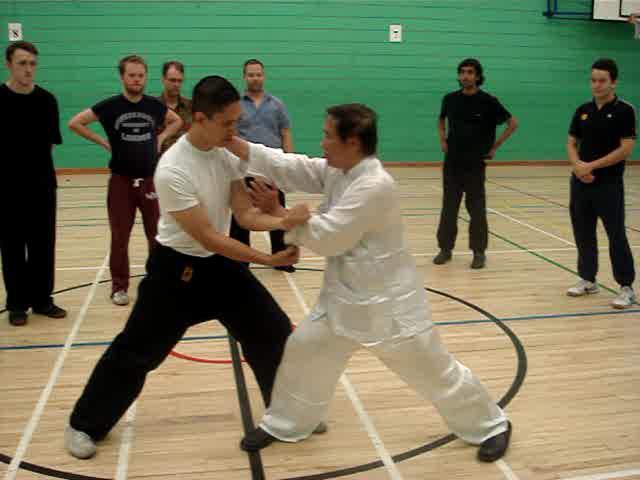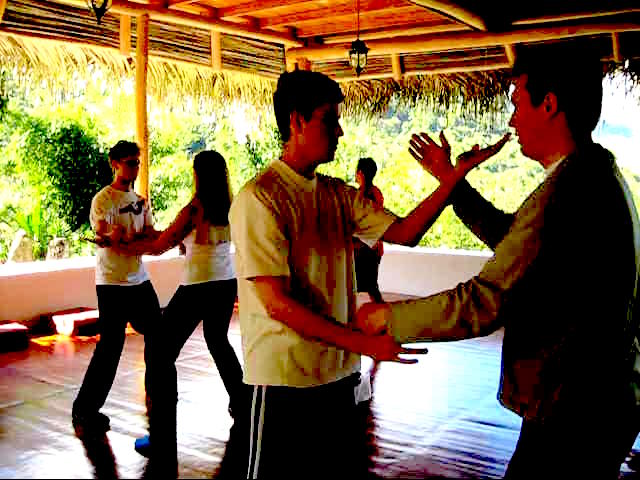HOONG KA MEN KIEW AND WING CHOON CHI SAU

Hoong Ka Asking Bridge
Question
May you please share with us pointers on the nature of Hoong Ka Men Kiew and Wing Choon Chi Sau? And advice on translating skills between the two?
David
Answer
The main purpose of Hoong Ka Men Kiew, or Asking Bridge, is to develop internal force, whereas the main purpose of Wing Choon Chi Sau, or Sticking Hands, is to develop sensitivity.
The onus of Asking Bridge is to press down an opponent’s arm so that the exponent can strike him, manifesting the principle of “kiew lei kiew seong ko”, or “when there is a bridge, go along the bridge”.
The onus of Wing Choon Sticking Hands is to be so sensitive that an exponent can respond correctly and spontaneous to an opponent’s movement, manifesting the principle of “loi lau hui soong”, or “retain when come, send when retreat”.
I recall that during the Special Wing Choon Course in Penang, course participants were so successful in training Sticking Hands blind-folded that a few participants, like Tim (Sifu Tim Franklin of England, for example) told me that they found it more effective in responding to an opponent’s attack when they were not looking at it!
Knowing the purposes of Asking Bridge and Sticking Hands will lead us to a few useful pointers. First let us examine some common mistakes many students make. Next, we examine some helpful practices that can enhance our results. Then we can examine how the results can improve not just our combat efficiency but also our daily life.
A common mistake in Asking Bridge is that many students, not from our school, tense their muscles to create more muscular strength. They do so because they do now know how to generate internal force. They have more strength, but at the expense of sensitivity, speed and good health. They also become tired easily.
Another common mistake is that many students use their body weight to add strength. This also happens frequently in Taijiquan Pushing Hands. If you let go of your arm, the student pushing his body forward may fall over, and you can strike him while he is off-balance.
In Sticking Hands, a common mistake is that students are pre-occupied in hitting their partners rather than focusing on developing sensitivity skills. This is due to their failing to realize the purpose of their training. They also tense their muscles which hamper energy flow and subsequently their sensitivity.
Another common mistake is that students tend to look at their partners’ movements rather than feel them. They may have better result initially when their sensing skills have not been developed, but it defeats the purpose of their training.
In both Asking Bridge and Sticking Hands, besides not realizing the purpose of their training, their training is also unsystematic and incomprehensive. Progress, if any, is haphazard. This means their training does not gradually build up step by step, and that it does not include all important steps.
If they are lucky, they may have inherited a routine of practice that their past masters worked out for them, and which is usually systematic and comprehensive. But because they do not understand the purpose of their training, they follow the routine blindly, perhaps using it for demonstration but without using it to train force or sensitivity. They miss the advantages of gradual progress and accumulated benefit, which are very important in any training.
Knowing these common mistakes not only enables us to avoid them, but also points us to better ways of training to attain our purpose more effectively. Two fundamental principles are that we know the purpose of our training, and that our training is systematic and comprehensive.
The purpose of Asking Bridge is to generate internal force, not muscular strength, in correct and spontaneous movements in our attack and defence. To generate internal force, it is necessary to be relaxed and focused at the same time. Students must also know how to generate an energy flow, and to consolidate the energy flow into internal force.
If students go straight to the techniques of Asking Bridge without first acquiring these skills, they would not achieve the purpose of their training, regardless of for how long they may train. It is like most chi kung practitioners practicing chi kung techniques as gentle physical exercise.
Our Shaolin Wahnam students are elite. They already have these fundamental skills, so they can go straight to Asking Bridge.
Having a solid base contributes much to generating internal force. So if students do not have good stances, not only they fail to generate good force, they also offer weaknesses that their opponents can exploit. Many students today have not spent sufficient time in stance training.
In Wing Choon Sticking Hands the purpose is to develop sensitivity. Obviously, the more relaxed students are, the better is their sensitivity. If they let their energy flow, besides being relaxed, their sensitivity is further enhanced. If students do not have these skills, their attainment in Sticking Hands will not be much even when they may practice for a long time. This explains why our students can achieve in a few days what other students may take months or even years.
They are different systems we can use to make our training systematic and comprehensive. In Asking Bridge and Sticking hands, we may use, for example, the four directions of hand strikes, namely top, middle, bottom and sides. Or, especially in Asking Bridge, we may use the twelve types of force like in Iron Wire. To make the training more comprehensive for combat and not just for hand movements, we may use the four categories of attack, namely striking, kicking, felling and chin-na.
To be systematic we may progress from the more simple and widely used techniques to the more sophisticated, letting one skill or technique built upon the previous one. If students learn how to respond to a strike, then a kick then return to another strike. If students practice any movements randomly, the training is not systematic. If they focus mostly on strikes, perhaps with some kicks, like many students do, but miss out felling attacks and chin-na, their training is not comprehensive.
If you are forceful but not sensitive enough to respond correctly and spontaneously, you will be at a handicap. Similarly if you are sensitive but not forceful in your attack and defense, you will also be at a handicap. In our Asking Bridge Course at Frankfurt in September, with the advantage of breadth and depth we learn to be both forceful and sensitive, and more.
Our results not only benefit us in our combat efficiency, but more importantly they also benefit us in our daily life. If you want to right wrongs, or even just to claim your right, you often have to be forceful. otherwise no one will be bothered. Even when you want to help others, some force is needed. I often have to be forceful like a slave-driver to get patients to practice their chi kung to get well.
But force may need to be applied in different ways. Sometimes you need to be elegant and persuasive to be forceful. Besides being forceful, you also need to be sensitive to the situation so that you can respond correctly and spontaneously. The skills acquired in the Asking Bridge course will be useful for such purposes.
At the course you will learn to translate or transfer between force and sensitivity, i.e. to adjust the right proportion between force and sensitivity learned in Asking Bridge and Sticking Hands, as well as from Pushing Hands and Kneading Hands.
Generally when you wish to focus on force, you consolidate energy. When you wish to focus on sensitivity, you let energy flow. An effective way to adjust between force and sensitivity, i.e. between consolidation and flowing, is the position of your wrist.
If you bend back your hand, you lock up energy at your arm and hand to consolidate it, making them forceful. It is like closing watergates of a dam to store water to generate force.
If you release the bend so that your arm and your hand make a smooth curve at your wrist, you let your energy flow, enhancing sensitivity. It is like openning watergates to let water flow.
Thus, a preferred hand form in Asking Bridge is the One-Finger Zen hand form. It consolidates energy for more force. A preferred hand form in Sticking Hands is the open palm. It generates energy flow to enhance sensitivity.
A Tiger-Claw hand form is in between. You bend your hand back, which is the orthodox way to form the Tiger-Claw, to consolidate force. If you want to focus on sensitivity, you relax your bend more like an open palm to generate energy flow to enhance sensitivity.
So, when you are practicing Hoong Ka Asking Bridge and you wish to have more sensitivity to listen to your opponent’s movement and even intention, you release your bend. When you are performing Wing Choon Sticking Hands and you want more force in your strike, you bend back your palm. In the Asking Bridge course in Frankfurt we shall do all these and more.

Wing Choon Sticking Hands
Four Sequences of Asking Bridge
Glimpse of Asking Bridge, Saariselka 2011
Treasure House of Kungfu Sets
Treasure House of Combat Application
The questions and answers are reproduced from the thread 10 Questions on Asking Bridge in the Shaolin Wahnam Discussion Forum.
LINKS
